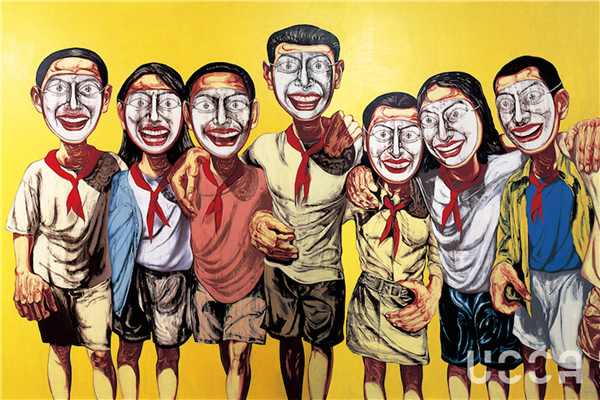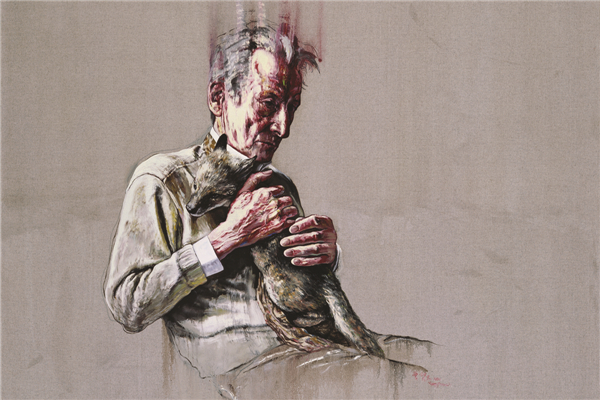
Blue, oil on canvas by Zeng Fanzhi.[Photo/China Daily]
Artist Zeng Fanzhi is tired of being associated only with his Mask series that commands eight-figure prices at auction. So he is holding an exhibition to try and dispel the notion that he is only a mask painter.

A piece from Zeng’s Mask series.[Photo/China Daily]
“I hate to be stereotyped. It’s time for ordinary people to get access to my real work,” he says.
“They will find that the Mask series is a very tiny part of my creations.”
He’s one of the world’s top-selling artists, whose The Last Supper, from the Mask series, sold for $230 million in 2013.
“I was happy at first, but then got stressed. An artist cannot be in ecstasy or in tension for too long. So I dealt the chaos, or else I would not be able to create anything,” says the 52-year-old.
He believes an artist has to be free and absolutely honest in his creations.
“Many collectors wanted to book my paintings. Even my father hoped I would paint more in the (Mask) series. But being booked is ridiculous and disastrous for an artist.”
Critics say Zeng’s early works like The Hospital series and The Meat series present the artist’s lament about cruelty and the fragility of life, but Zeng says he only picks up his brush when he is really touched-and it is all instinctive.
Zeng completed these two series when he was still a senior at the Hubei Institute of Fine Arts in Wuhan.
“It was sensational to paint this bloody stuff. It wasn’t acceptable as graduation work. At first, I handed in a draft sketch of Tibetan scenery as my tutor required, but I fooled him by handing in The Hospital Triptych finally.”
Born in Wuhan in 1964, Zeng has a typical chivalrous and vagabond streak about him, much like the city he grew up in, which provided the inspiration for his early creations.

Zeng Fanzhi, artist[Photo/China]
“I lived closed to a meat-processing plant and a hospital where I would go to the washroom every day. Those familiar scenes triggered my desire to paint.”
The ongoing exhibition, which comprises more than 60 works, is Zeng’s largest solo exhibition to date. It has been running at the Ullens Center for Contemporary Art in Beijing since Sept 19.
The exhibition is called Parcours, after a French word that means to stroll through.
The designer of the exhibit, Japanese architect Tadao Ando, says: “I came up with an idea where the audience can feel the in-depth world of the artist’s creation if they see the artwork through a series of windows cut out of several parallel walls.”
One of the pieces the audience sees through the windows is the artist’s self-portrait.
In the painting, Zeng is seen in a red Buddhist robe sitting on a stool, barefoot, echoing the work of a pair of boots at the entrance of the exhibition.
“That’s not a cigarette in my hands-it’s a pen, with a line winding in the air. This self-portrait accurately describes my state of mind at that time, tranquil and detached.
“I think I’m doing well in protecting my territory.”
Anyone who has been to his studio will understand why he is not disturbed by the chaos from outside.
Zeng, who uses gardening as a form of meditation, often paints while listening to his favorite classical music-Tchaikovsky or Smetana-in his studio.
Besides oil paintings there’s also a dark and mysterious room in the exhibition.
For the first time, Zeng is showing his Paper series-experimental work done since 2009, when he was excited after acquiring a piece of handmade paper.
Zeng, who is fascinated by the texture and grain of the paper, just adds very weak lines with mineral water colors based on what he observes in the texture, and the landscape that exists on the paper.
“The paper does 30 percent of the painting. I paint 30 percent. And the rest is done by each viewer,” he says.
Basically, one does not need to understand the theory of art to appreciate a painting.
However, if one understands both Western art and traditional Eastern art, especially paintings from the Song Dynasty (960-1279), one can enjoy his works on paper even more.
“Even if you don’t know art history, art can be rewarding if you are patient. You have to communicate with the work, stare at it for a while and feel it. Just a quick glance will leave you disappointed,” he says.

Lucian Freud, Artist series (2011).[Photo/China Daily]
That’s why Zeng has ensured that the exhibition room is dark, and it takes as long as one minute for a viewer’s eyes to adapt to the environment.
Zeng also believes that a calm mind is important to enjoying art. “Only when one is calm, one can notice subtlety.”
Meanwhile, Zeng has not given up on oil painting and returns to it from time to time.
“I have to be absent for a while, or else I’ll become too obsessed and blind,” he says.
Speaking of his regrets, he says he once drew a portrait of Lucian Freud, one of the greatest artists from the United Kingdom, and was just about to send it to him when he learned that the artist had passed away.
As for his other works, there is the Chaos series.
Zeng held two brushes with his right hand and painted alternately-one sketches, and the other disturbs the painting.
This, Zeng says, has created an unexpectedly interesting effect.
“Order is meant to be broken and established. So, when the new order becomes a shackle, it has to be broken again.”
If you go
Parcours
Sept 19-Nov 19. Great Hall, Nave at the Ullens Center for Contemporary Art, 798 Art zone, Chaoyang district, Beijing. 5780-0258.
